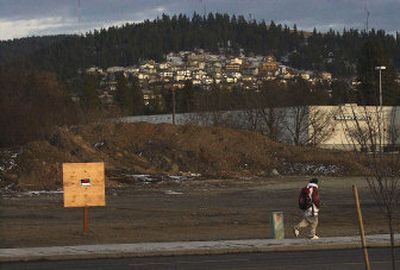Wetland mysteriously filled in

A chunk of land at 44th Avenue and Regal Street that could someday house a Wal-Mart is the site of a whodunit of sorts.
Neighbors recently pointed out that a wetland on the west end of the nearly eight-acre South Hill parcel is missing.
The small patch, which harbored reed canary grass and served as a natural filter for phosphorous, oil, antifreeze and other pollutants, was the apparent victim of human meddling.
Land owners can move up to 50 cubic yards of dirt without a grading permit, but filling a wetland requires city approval.
“We find people get themselves into trouble because they don’t consult with the experts before starting the bulldozer,” said Chris Merker, a wetland biologist for the Washington State Department of Ecology.
While no one is stepping up to take the blame for the work on the South Hill property, a number of theories are floating around.
Lamar Fielding, a retired educator and neighbor in the area, thinks the wetland disappeared during the city of Spokane’s Regal Street upgrade last summer, when contractors piled mounds of dirt on the property.Merker said his “best guess” is that the wetland was filled in the past couple months when grading was done there. The land is owned by developer Harlan Douglass.
Wal-Mart Stores Inc. was quick to distance itself from the wetland quandary. “We weren’t a part of that one. Whatever happened is between Harlan (Douglass) and the contractor and the contractor and the city,” said Jennifer Holder, a Seattle spokeswoman for Wal-Mart, which is based in Bentonville, Ark.
Steve Haynes, a city planner for Spokane, said workers on the city’s street project had nothing to do with the wetland’s disappearance.
Based on ongoing reviews of the property, Haynes said his department believes the wetland was filled two or three years ago, before Douglass purchased the land. Douglass was unavailable for comment, as was former property owner Dr. Ralph Berg.
“We don’t know specifically who, or why that was done. It just happened,” Haynes said, adding that whoever illegally filled the wetland may have also disrupted a drainage route.
Haynes couldn’t say what the penalty was for filling a wetland but said the city likely wouldn’t try to track down the person responsible.
Merker inspected the property last week for the city, which is considering a request to subdivide the property. He recommended that the landowner be required to replace the filled-in wetland and that the area be inventoried because the east side of the property contains what appears to be another wetland.
“My feeling is it should be treated as a wetland unless there’s compelling evidence to say that it’s not,” Merker said of the possible new wetland.
The slice of land at 44th and Regal has changed dramatically over the years. Today, surrounded by homes and commercial developments, its front face resembles a preconstruction site more than a habitat. Many of the trees have been cleared.
But fifteen or so years ago, said Fielding, who has lived in the area since 1964, much of the site was covered with water.
“At one time it was wetland, believe me. It was wet year-round over there,” Fielding recalled.
During that time members of Park Heights Baptist Church looked at buying the property to build a new church. David Vorpahl, who chaired the building committee, said a city employee discouraged the group from buying the property because it contained a wetland.
“We thought that would be a good location for the church,” said Vorpahl, who now wonders why a big retail development is being considered there.
The status of the property’s wetland has, at times, stymied even the experts. In 1996, Haynes said, the Department of Ecology determined there were no wetlands on the property. About that time, the city allowed a change to commercial zoning.
It wasn’t until 2001 that the front wetland — the one that was recently filled — was identified by a company working for another potential developer.
Merker said wetland classifications can come and go amid the area’s often drought-like conditions.
“We live in almost a desert in Eastern Washington. As a result, oftentimes these wetlands don’t have water in them sometimes for a couple years in a row,” he said.
Soil saturation is a major factor in determining wetland status, Merker said, adding, “wetlands can exist without above-ground water ever showing.”
Despite the possible presence of another wetland on the east part of the property, the Department of Ecology couldn’t block Wal-Mart from going in there.
Although the agency provides a report to the city during the state environmental review process, Merker said the final decision on whether Wal-Mart can build lies with the city of Spokane.